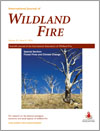
International Journal of Wildland Fire
Volume 25 Number 8 2016
RESEARCH FRONT: Forest Fires and Climate Change
WF15012Regional aspects of modelling burned areas in Europe
This paper presents a series of improvements to the quantitative modelling of burned areas in Europe under historical climate. Our analysis is carried out for 2000–2008 for 17 European countries. The annual burned areas modelled by an improved version of the Standalone Fire Model (SFM) are in good agreement with historical observations.
WF15028How drought-induced forest die-off alters microclimate and increases fuel loadings and fire potentials
Drought-induced forest die-offs are expected to change fuels and microclimate and likely influence fire behaviour. Fuel loading and microclimate measurements following die-off in south-western Australia showed that die-off plots had 20% higher quantities of 1-h fuels and elevated temperature and wind, which when combined, predicted a 30% higher rate of fire spread.
WF15010Too much, too soon? A review of the effects of increasing wildfire frequency on tree mortality and regeneration in temperate eucalypt forests
We use south-eastern Australia as a case study to review effects of increasingly frequent and severe wildfires on tree mortality and regeneration in temperate eucalypt forests. We propose conceptual models to articulate these changes and highlight knowledge gaps in our understanding of alternative stable states in these forests.
WF15013Lack of soil seedbank change with time since fire: relevance to seed supply after prescribed burns
Environmental variability, geographic variability and time since disturbance influence plant diversity in soil seedbanks. Knowledge around the relative importance of each of these factors is lacking. This research examined the influence of environmental, geographical and temporal variability on species richness and composition in the soil seedbank within a fire-prone heathy-woodland.
WF15026High-severity fire reduces early successional boreal larch forest aboveground productivity by shifting stand density in north-eastern China
Fire severity affects Chinese boreal larch forest aboveground productivity (ANPP) through its influence on forest structure. Changes in recruitment composition or the increase of understorey ANPP cannot offset the decrease of sapling ANPP in high-severity burned areas where low stand density is a strong limiting factor.
WF15007Targeting forest management through fire and erosion modelling
Fire intensity and soil erosion models were used on a 1500-km2 forested watershed to aid in targeting areas that would most benefit from forest management to reduce fire risk. Soil erosion following wildfire was estimated to be reduced by 56 percent if areas most susceptible to fire and erosion were thinned.
WF15172Fire effects on pollination in a sexually deceptive orchid
We observed pollinator visitation to flowers of sexually deceptive Caladenia tentaculata and related it to post-fire age class at multiple spatial scales. Visitation was highest when the sample location was recently burnt and there was long-unburnt vegetation in the surrounding landscape.
WF15109Places where wildfire potential and social vulnerability coincide in the coterminous United States
We identified places in the US that are vulnerable to wildfire hazards. We combined data describing wildfire potential and social vulnerability. We mapped and compared wildfire potential and social vulnerability across wildland–urban interface categories. Our analysis supports evaluating priorities in wildfire hazard prevention and mitigation efforts.



